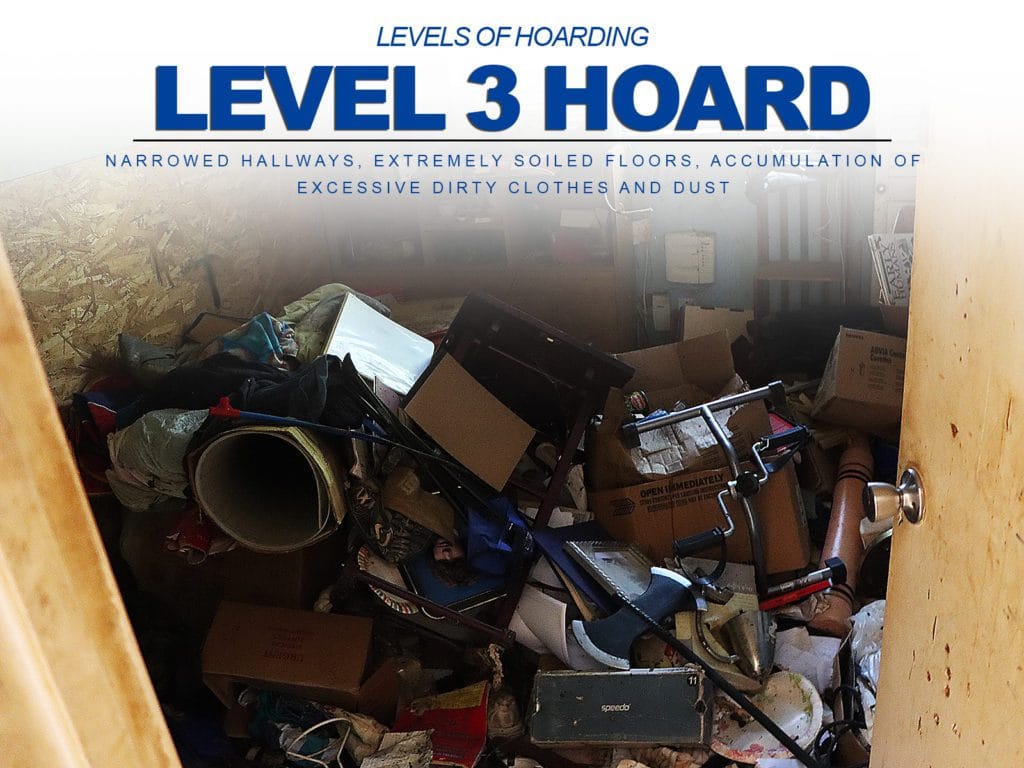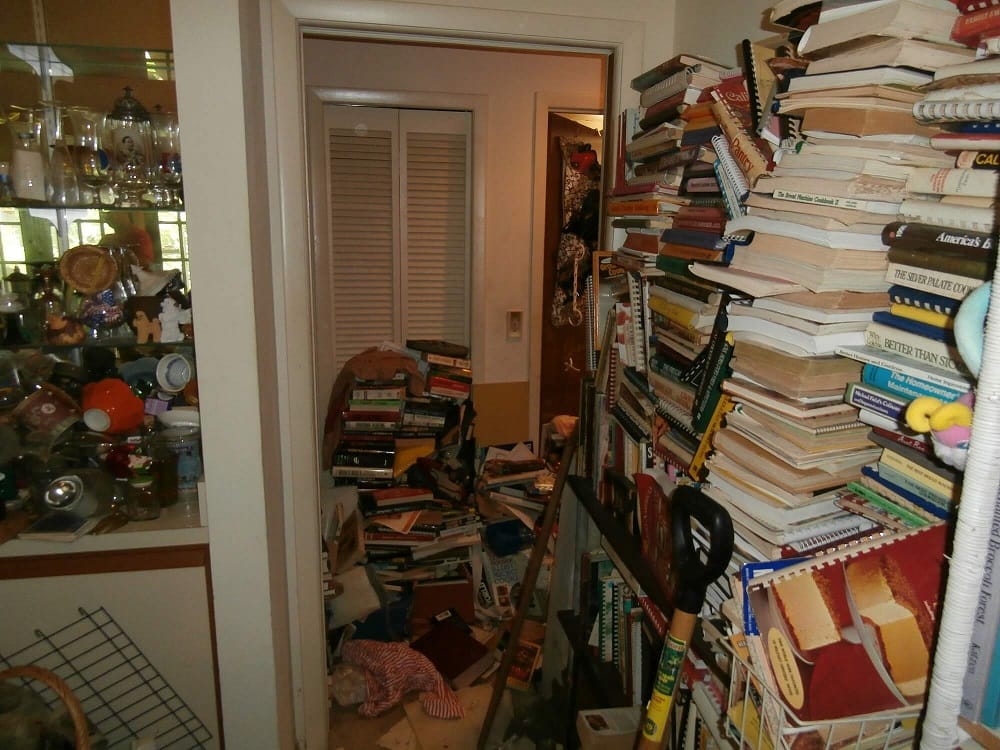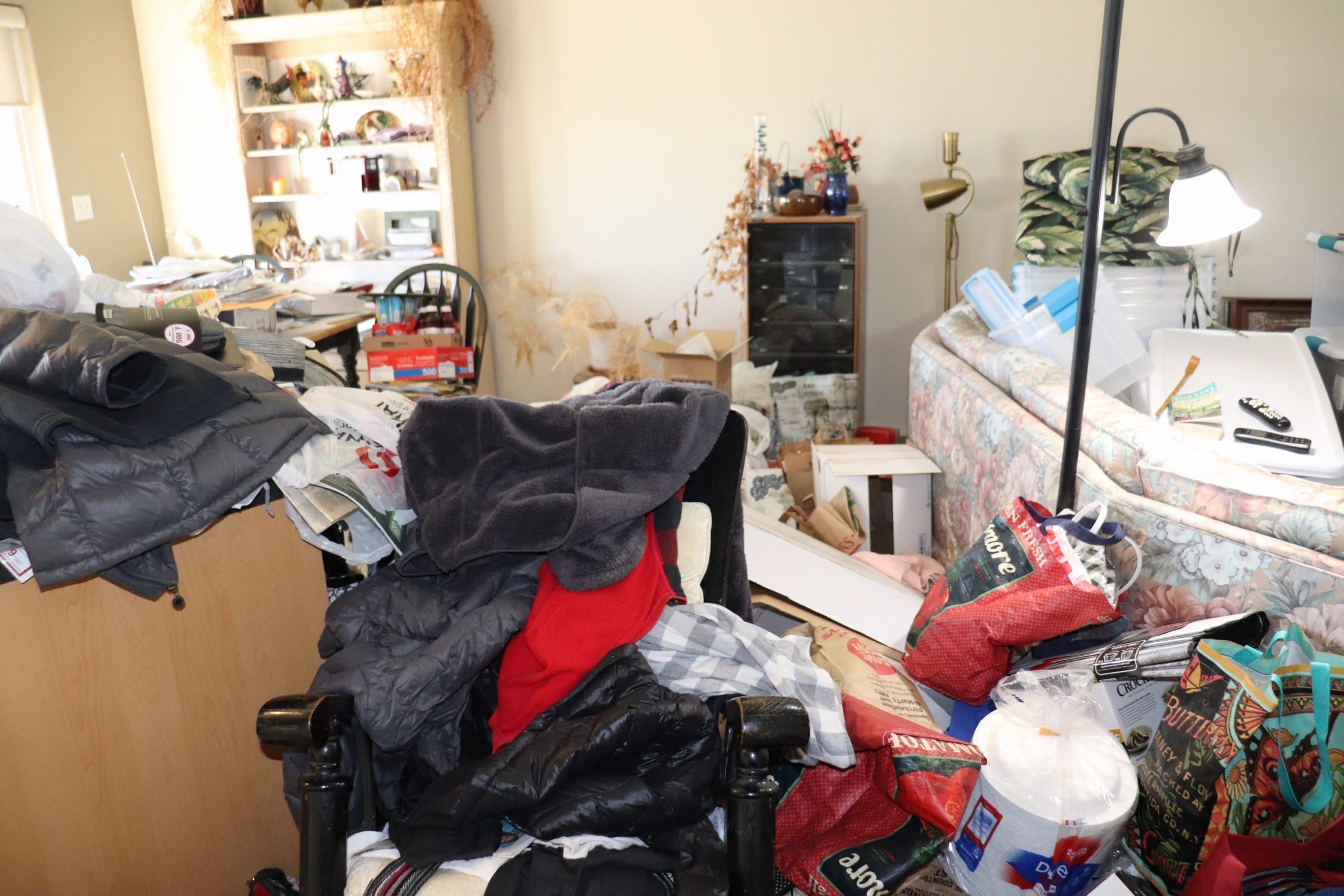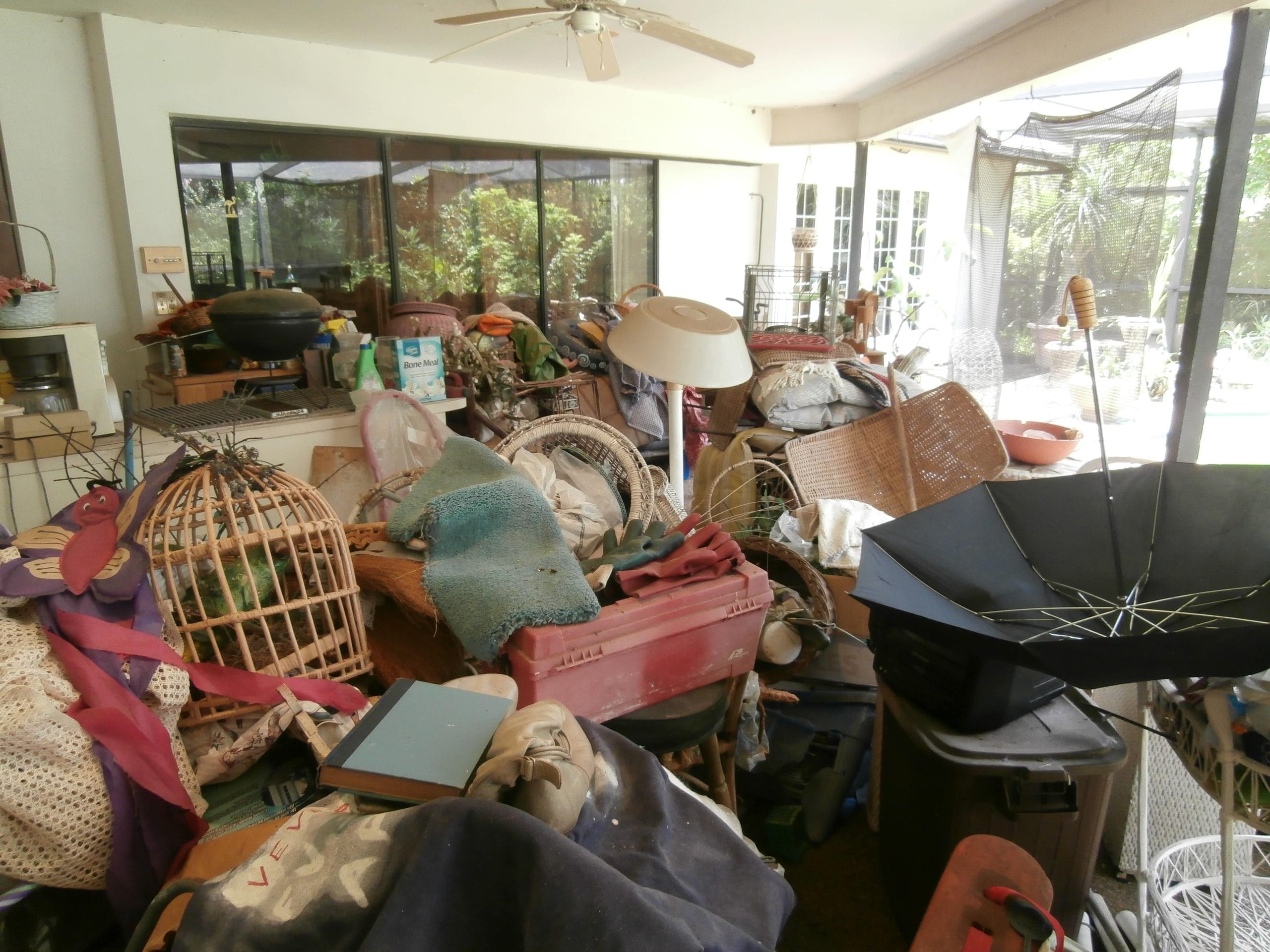Understanding Level 3 Hoarding
Hoarding is a condition characterized by the obsessive and irrational need to keep excessive belongings, trash, or even animals. As hoarding progresses, it leads to unsafe, unsanitary living conditions and potential health risks.
The National Study on Compulsive Disorganization developed a Clutter-Hoarding Scale to define five levels of hoarding. Level 3 hoarding represents a critical turning point – the hoarder is often unaware of the severity of their situation, downplays risks, and may become defensive when confronted.
Did you know? Studies show that hoarding disorder affects approximately 2-6% of the population, with most cases worsening over time without intervention.
What is Level 3 Hoarding?
At Level 3, daily living becomes significantly impaired as clutter begins taking over multiple areas of the home. A hoarder may struggle with basic hygiene, have structural damage in the home, and experience pest infestations.
Key Characteristics of Level 3 Hoarding:
- Poor Personal Hygiene
- An Excessive Number of Pets
- Evident Flea, Spider or Rodent Infestation
- Strong Odors in the Hoarders Home
- There is So Much Stuff that Tidying Up Isn’t Possible
- Extremely Soiled Flooring
- One or More Unusable Bathrooms or Bedrooms
- Hallways Are Narrowed
- Accumulation Outside of the Hoarded Home
- Two or More Items in Disrepair for 6 Months
- Light Structural Damage in the Hoarders House
Warning: These indicators suggest that the hoard has escalated to a critical level, and professional intervention is strongly recommended.
Key Indicators of Level 3 Hoarding
Poor Personal Hygiene
Due to obtrusive piles of stuff and broken plumbing, personal hygiene is visibly declining. Dirty clothes are worn, teeth are not being brushed, bathing isn’t occurring as frequently as it should, and the toilet may not work. This is the first stage where the declining hygiene of a hoarder becomes visible. Visitors and friends, whether inside or outside of the hoarded property, will start to wonder why the hoarder isn’t taking care of themselves.
Quick Tip: A compassionate approach can help a hoarder recognize the impact of their hygiene issues on their health.
An Excessive Number of Pets
The number of animals in the house now overwhelms the hoarder’s ability to care for them. Pet excrement will be throughout the house and not centralized into a few locations. Feces and urine will be present on items within the hoard itself. The animals themselves may start suffering from medical ailments that the owner cannot pay for due to the daily upkeep cost on their hoarded animals. Pets will not be adequately spayed or neutered, increasing the risk of the animal population exploding beyond what already exists.
Warning: Animal neglect and overcrowding can result in severe health and legal consequences.
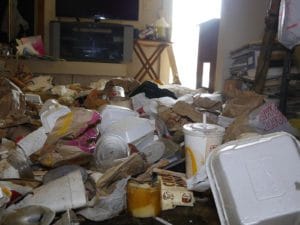
Evident Flea, Spider or Rodent Infestation
Pests can be seen in the home. Fleas are found on furniture, spider webs exist between objects in the hoard, and rodents will occasionally be seen jumping between objects around the house. The house is not yet overrun by vermin, but immediate action needs to be taken to restore the hoarders’ living space into something livable and healthy.
Warning: Immediate pest control and professional cleaning are necessary to restore livability.
Strong Odors in the Hoarders Home
The amount of rotten food, dirty dishes, garbage, and pet excrement creates a pungent odor within the hoarder’s house. It is not yet overpowering, but it is strong and disagreeable. It permeates all spaces within the home, but it can’t yet be smelled outside.
Health Risk: Prolonged exposure to these conditions can cause respiratory issues and infections.
There’s so much Stuff that Tidying up Isn’t Possible.
At this stage, clutter accumulates so rapidly that tidying up is no longer an option. The home may:
- Be impossible to navigate without stepping over piles.
- Have entire rooms filled floor to ceiling with hoarded items.
- Contain layers of dust and filth.
- Have a mix of clean and dirty clothes scattered throughout.
Strongly Recommended: Hiring a professional hoarding cleanup team is often necessary to clear out hazardous materials safely.
A professional cleaning company is usually needed and many times can be covered by insurance. We have noticed often thick layers of dust over everything in the hoarded house. Level 3 hoarders have an excess of dirty clothes lying around the house. This clothing may be mixed in with clean clothes, and the hoarder may no longer have a working washer and dryer.
Extremely Soiled Flooring
The house’s clutter, vermin, and pets will have created a situation on all the floors that cannot be rectified by a deep hand scrub or a carpet cleaner. Layers of debris have been ground into tile and carpet to the point that the original color of the surface is often not visible in main walkways.
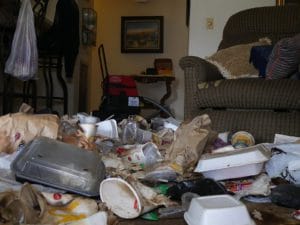
Quick Tip: Flooring in these cases often requires complete replacement due to contamination.
One or More Unusable Bathrooms or Bedrooms
Items have entirely taken over at least one bedroom or bathroom. Not only is the bed or tub unusable, but the entire space is filled with so much stuff that it is impossible to enter the room. This is the first level that guarantees the non-use of an entire room in the house.
Warning: Lack of access to functioning bathrooms increases the risk of biohazard contamination.
Narrowed Hallways & Blocked Entryways
Surface and space underneath furniture are stuffed, but the clutter has also started to accumulate around the perimeters of rooms and hallways. This impedes natural movement through these spaces, and often pathways have been created through what is quickly becoming a wall of stuff.
Clutter begins to form walls, narrowing walkways to dangerous levels. This:
- Restricts movement within the home.
- Creates fire hazards by blocking escape routes.
- Puts residents at risk of injury from falling debris.
Quick Tip: Escape routes should be cleared first during cleanup efforts.
Accumulation Outside of the Hoarded Home
The hoard has spilled outside and is now viewable to people approaching the house or property. Due to accumulation, entire porches will be unusable, and clutter will exist in piles forming in yards.
When hoarding spills outside the house, neighbors and local authorities often take notice. Signs include:
- Piles of discarded items on porches and in yards.
- Blocked driveways or sidewalks.
- Complaints from neighbors regarding unsanitary conditions.
Quick Tip: At this stage, legal intervention may occur, so professional cleanup is highly recommended.
Two or More Appliances in Disrepair for 6 Months
Two or more of the appliances within the hoarded home are unusable. This is usually because they quit working, often for a simple reason, and the hoarder couldn’t reach the appliance to fix it. Things like a bathroom may be overflowing onto objects stacked around it, and the bathroom no longer serves its purpose to the owner.
Light Structural Damage in the Hoarders House
There is an area of the home that now has structural damage due to the size of the hoard and the inability to access the immediate area. The roof may be leaking, the floor may be buckling, or the drywall has cracked. Because of the excessive number of items in the hoarded home, it is impossible to address this structural damage without cleaning the space.
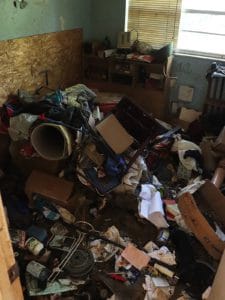
Warning: Hoarded homes with structural damage pose serious safety risks to occupants.
How to Help a Level 3 Hoarder
Hoarding is characterized by symptoms that are distressing to friends, family, bosses, and neighbors. A level 3 hoarder is most likely in a significant amount of denial about the severity of their situation.
Steps to Help:
- Express concern without judgment – Avoid shaming or blaming.
- Encourage professional help – Therapy and cleanup services can make a difference.
- Prioritize safety – Remove biohazards and clear pathways first.
- Hire hoarding cleanup specialists – Professionals ensure proper sanitization and restoration.
Why Choose Spaulding Decon for Hoarding Cleanup?
We will provide you with the professionals you need to assist the hoarder in your life. PPE gear will almost always be required in level 3 hoarding situations. Get expert help cleaning the garbage and feces out of the hoarded home.
At Spaulding Decon, our trained biohazard remediation professionals know how to clean up a hoarder’s home, and we understand the emotional attachment that exists to the belongings. Our teams can create custom cleanup plans while working with mental health professionals to ensure that your loved ones get the help and support they need during the difficult cleanup process.
Need Immediate Help? Call 866-726-2316 for Professional Hoarding Cleanup Services.
Take Action Today!
Don’t wait for Level 3 hoarding to worsen. Early intervention can prevent severe consequences.
- Recognize the warning signs.
- Encourage small cleanup efforts.
- Seek professional help before it escalates.
Next: Level 4 Hoarding Explained – Learn what happens when hoarding becomes even more severe and how to intervene before it’s too late.
Call Spaulding Decon today at 866-726-2316 for expert hoarding cleanup.
Find a Hoarding Cleanup team nearest you: Spaulding Decon Locations
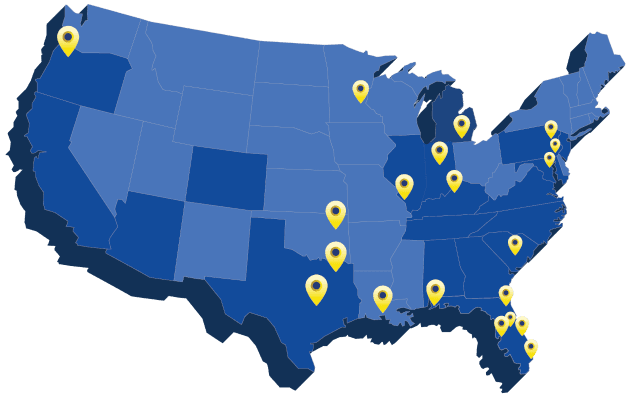
The 5 Levels of Hoarding: Understanding Hoarding Disorder
Overview: All 5 Levels of Hoarding Explained
Level 1 Hoarding
Level 2 Hoarding
Level 3 Hoarding
Level 4 Hoarding
Level 5 Hoarding

